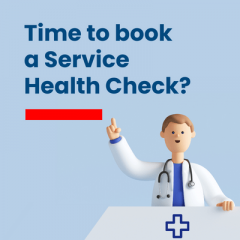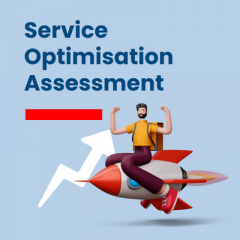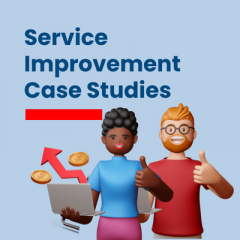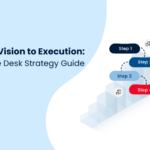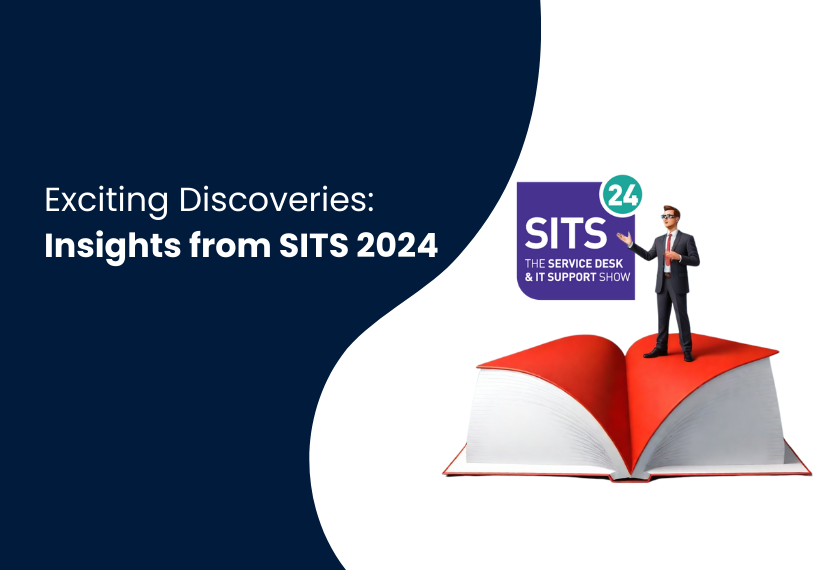
Last week, we had the opportunity to be a part of SITS—The Service Desk & IT Support Show—and we have some stories to share! Let us take you on a little journey through our experience at this year’s event.
In this blog we will share our experience at SITS 2024, discuss some of the popular trends and topics we observed there, and provide more information about our panel discussion.
Firstly, if you have attended SITS before you probably already know what to expect but if you haven’t had a chance yet, let us set the scene for you.
What can you expect when attending SITS?
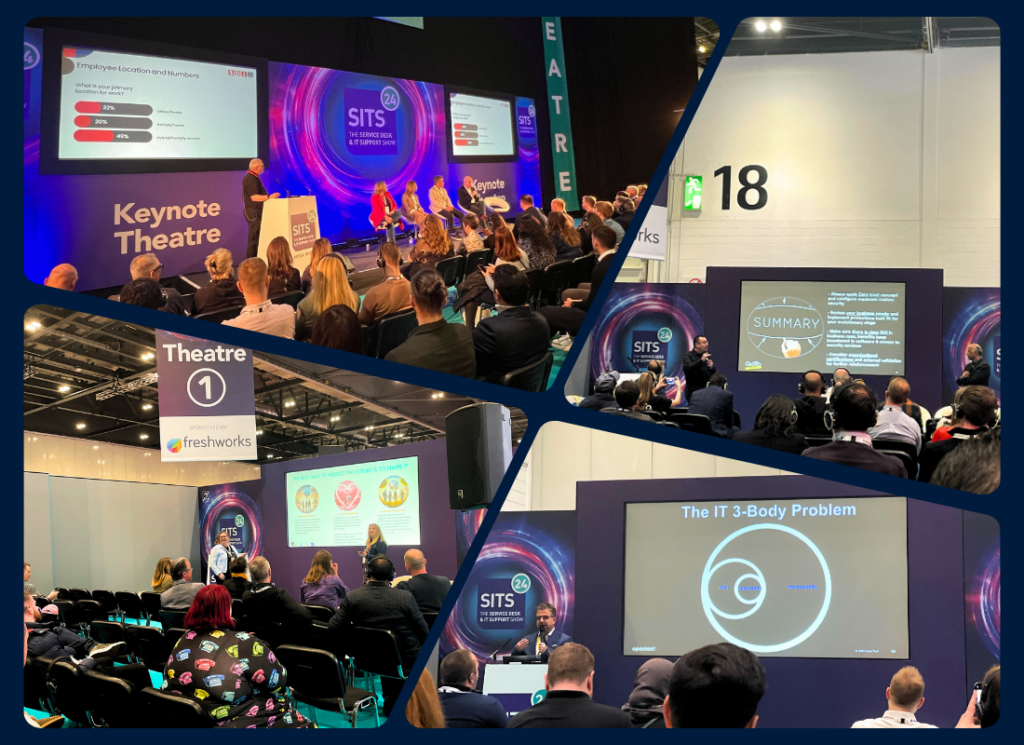
Usually, the first thing you notice on stepping foot inside the show is a large hall filled with eye-catching stands, excited visitors, buzzing speaker sessions and impressive product demos.
This year was no different – with the addition of a supercar greeting you near the entrance and a giant robot wandering the aisles! It’s like stepping into a world where everyone speaks the language of IT support, is looking expectantly to the future and shares a mission to power service excellence.
🎙️ Now, let’s talk about the sessions!
There were so many interesting topics being discussed, from cybersecurity to career paths in IT service management. While we cannot cover every session here, a few topics really stood out to us:
Importance of creating a psychological safety
One prominent topic we noticed this year was creating happy and mentally healthy workplaces. It was eye-opening to learn about the importance of psychological safety and how line managers can play a big role in supporting their teams.
When employees feel psychologically safe in the workplace, they are more productive, engaged, and motivated. They feel comfortable sharing their ideas, asking questions, and seeking feedback.
As our dear friend Daniel Breston always says, “It’s not just about fixing technical issues; it’s about fostering a culture of well-being and satisfaction.”
Security should be a priority in business strategy
With the ever-growing threat of cyberattacks, organisations are realising the importance of having robust cybersecurity policies and programs in place. A few sessions covered topics such as cybersecurity education and remote support security.
Vasileios Karagiannopoulos of the University of Portsmouth shed light on the challenges organisations face in developing and implementing effective cybersecurity measures. This session raised (concerning) questions about low overall levels of reporting a breach and very low levels of cybersecurity education.
“It was found that small businesses (30%), micro-businesses (14%) and charities (18%) had the lowest level of cybersecurity training in the last 12 months. “
In another session, Csaba Járomi of GoTo and Darren Bayney of BT explored considerations for ensuring the security of remote IT management and support tools. They shared some practical strategies for mitigating risks and safeguarding sensitive data across diverse devices and locations.
AI and Automation are reshaping ITSM
As we expected this year, several topics covered the important role of AI and automation technologies in ITSM. These sessions provided valuable insights into the benefits, challenges, and best practices of integrating AI and automation technologies into IT operations.
It was exciting to learn more about the opportunities these technologies offer to companies, from automating routine tasks and ensuring security to improving efficiency, productivity, service quality, and experience.
In his session, Gustav Elveros of Ebbot also addressed essential considerations for ensuring AI’s secure and ethical implementation in ITSM. Marc Morgan-Davies of BeyondTrust shared some strategies companies can use to balance productivity gains from automation and AI with security measures.
Optimising service delivery across the enterprise
Many sessions focused on ITSM and ITIL best practices, including navigating the ITSM tool selection process, demonstrating value from investments in service management, using a metrics model for ITSM/ITIL, and moving from service desk to customer value.
For example, Joel Eijssen of OpenText gave a session on the topic of how green IT services really are. In his session, Joel emphasised the need to make IT services trustworthy and reliable to make customers happy in a sustainable way.
Other sessions, like the one by Shaun Brown of GEA and Sami Kallio of HappySignals, discussed how IT experience data and insights can improve decision-making and business results.
This is what we talked about in our panel session
We hosted a panel discussion called “Strategic Agility: learn fast, act fast,” led by our Chief Delivery officer, John Noctor, and a brilliant group of panellists: David Wright (our Chief Value and Innovation Officer), Duncan Watkins (Principal Consultant at Forrester), Nia Hatchett (Head of IT Service Delivery Age UK), and Sarah-Jayne Bulley (Euromonitor).
So, what was discussed?
We shared exclusive insights from our unpublished SDI research, ‘Service Desk Benchmarking 2024.’ Despite economic worries and financial constraints across many industries, the outlook for future staffing levels is positive.
📊“Based on SDI Benchmarking survey 2023/24, over 40% of companies expect staffing levels to increase over the next 12 months.”
We talked about how work location affects the new workplace dynamic after COVID-19. Some organisations still face challenges in this regard, but it’s good to see that many are embracing different workforce location strategies.
On the other hand, we found that over two-thirds of respondents said they do not conduct regular employee satisfaction surveys, whereas only 11% don’t measure end-user experience. This means that many organisations prioritise user experience over employee experience, raising some questions about experience management.
📈 “Service Level Agreements (SLAs) are still the prevalent method of measuring customer performance, with 77% of people saying they have SLAs in place. But a surprising outcome was that 0% said they had Experience Level Agreements (XLAs) in place. “
Although XLAs have been causing a lot of buzz in the ITSM industry, it seems there is still a lack of knowledge on creating, communicating, and agreeing on them with the business. Also, there may be confusion about what targets and measurements should be included in an XLA.
Is it worth coming to SITS?
If you were to ask us if it is worth visiting SITS, our answer is YES!
If we had to pick one word to sum up our experience at SITS, it would be “inspiring.” But it wasn’t just the sessions that got us excited this year. We got to see how technology is evolving and shaping the future of IT support.
We met so many amazing people, from fellow IT professionals to industry experts. And it’s always inspiring to hear different perspectives and learn from each other’s experiences.
So there you have it – our little adventure at SITS. We can’t wait to see what next year’s event has in store!






